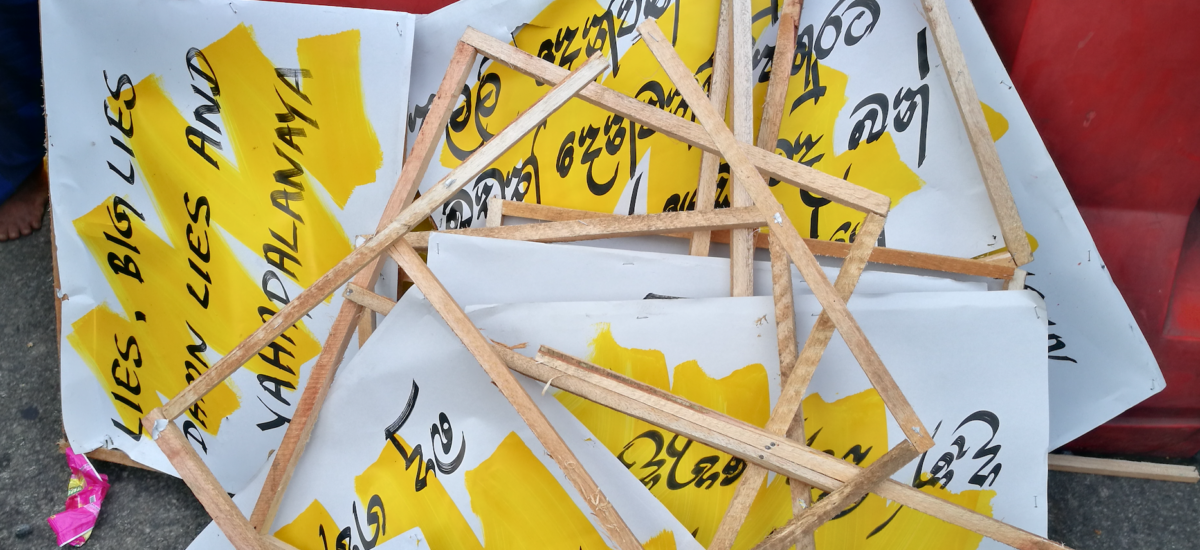Featured image by Raisa Wickrematunge
On September 5, Colombo was nearly empty even during the after-school rush hour. The reason was the Joint Opposition’s Jana Balaya rally, the location of which remained under wraps until the last minute. What was known was that participants would join from across the country and converge on the capital.
Several workplaces closed early, in anticipation of clashes.
Workers in Fort risked life and limb clinging dangerously onto windows to get home before the #Janabalaya protest converged at the Lake House roundabout this afternoon
Pic by Indnil Usgoda Arachchi #?????????? #lka #SriLanka pic.twitter.com/uEpFhVsHsI
— Sunday Observer (@observerlk) September 5, 2018
Map showing key rallying points
A key focal point was the Bo Gaha junction in Pettah, where Namal Rajapaksa and former Defense Secretary Gotabhaya Rajapaksa were supposed to join the rally.
Police lined the road leading to the Galadari hotel, with barricades having been readied the night before.
Pettah was soon flooded with rally participants, bussed in from around the country. Their T-shirts and headbands revealed the journey they had made – there were participants from Biyagama, Anuradhapura, Matara, Gampaha and Beruwala as well as from Colombo.

Having suffered defeat in the 2015 Presidential elections, the Joint Opposition clearly wanted to show that it had popular support across professions, age, race, and religious beliefs.
Farmers, wearing traditional amudey, a few brandishing sheaves of paddy, walked alongside white-collar professionals in office attire and sarees. Elderly men and women were flanked by parents carrying young children on their shoulders.
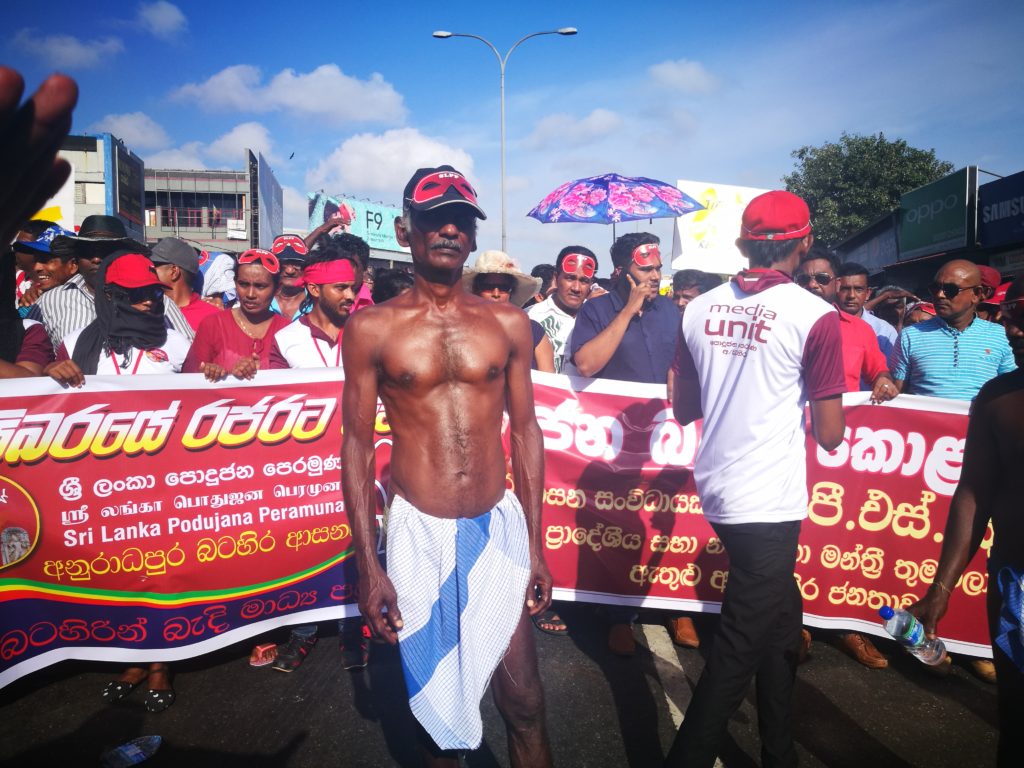
Front and centre, and standing shoulder to shoulder in the scorching sun were a group of Buddhist monks, a number of imams, and a swami. Women in hijabs carried a banner, representing a contingent from Beruwala. The placement was undoubtedly deliberate – during the previous regime, there were continuous allegations made of State inactivity around violent riots targeting Muslims and Christians, mostly notably in Aluthgama in 2014. More insidiously, allegations made by former editor of the Ravaya newspaper, Victor Ivan, revealed possible links between the former Defense Secretary Gotabhaya Rajapaksa and the BBS which were never refuted.
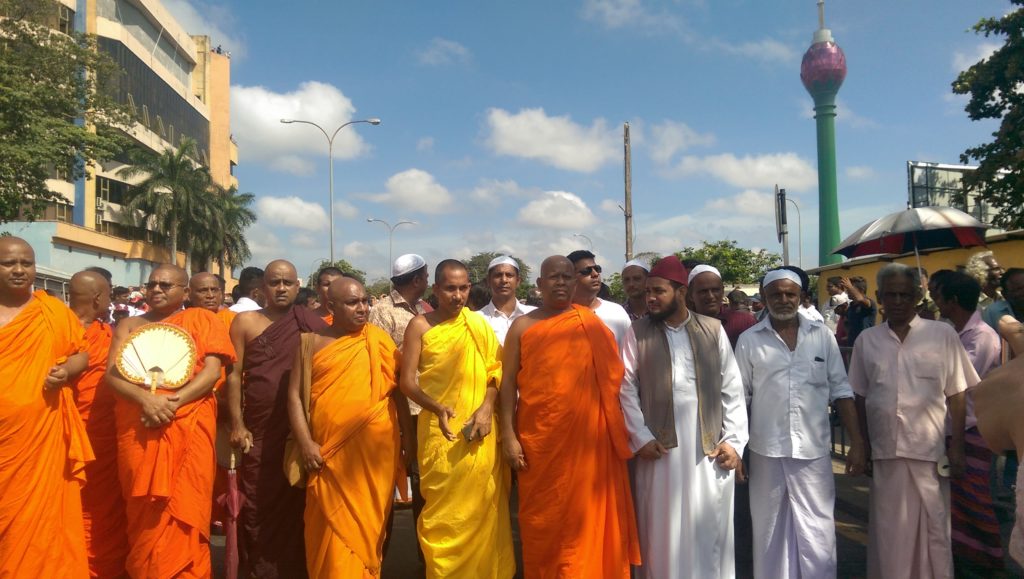
Now, the Joint Opposition shouted slogans through loudspeakers castigating the government for creating division in the country.
A closer look at the signage at the rally touted sentiments that were all too familiar – “The Government where the Tigers awake” read one sign. “Vijayakala is free, but the war heroes are angry” read another. Despite the veneer of inclusivity, the Joint Opposition was simultaneously trying to appeal to the nationalistic sentiment that has won them votes in the past.
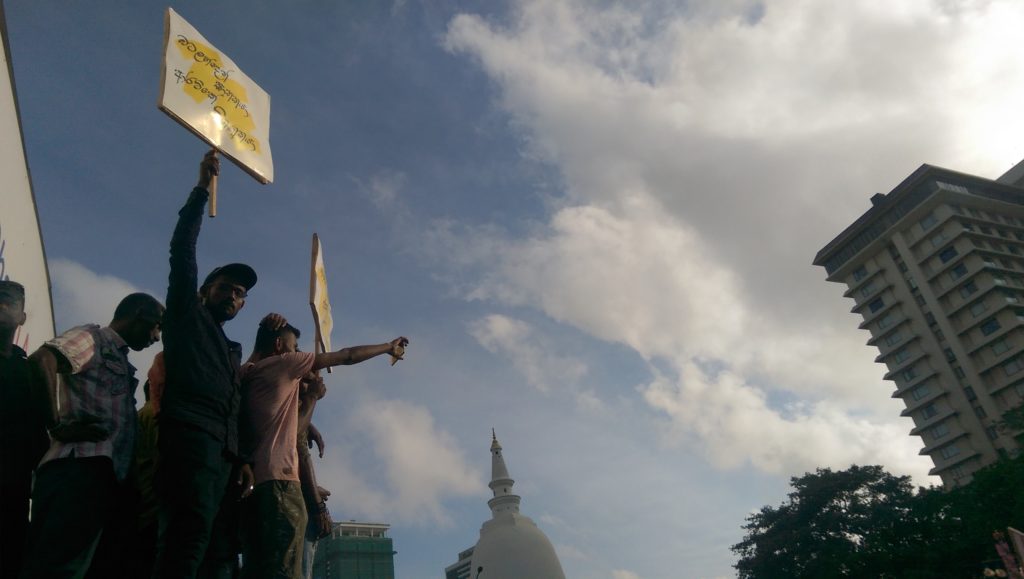
Some of the posters seen at the #JanaBalaya protest today – corruption, economic decline & nationalistic sentiments highlighted in the signage. #?????????? #lka #SriLanka pic.twitter.com/BDjMaGTI5r
— Groundviews (@groundviews) September 5, 2018
The younger Rajapaksa was greeted with cheers when he joined the rally at Pettah. After speaking a few words though, he was swiftly whisked away down a side street, as was former Defense Secretary Gotabhaya Rajapakse.
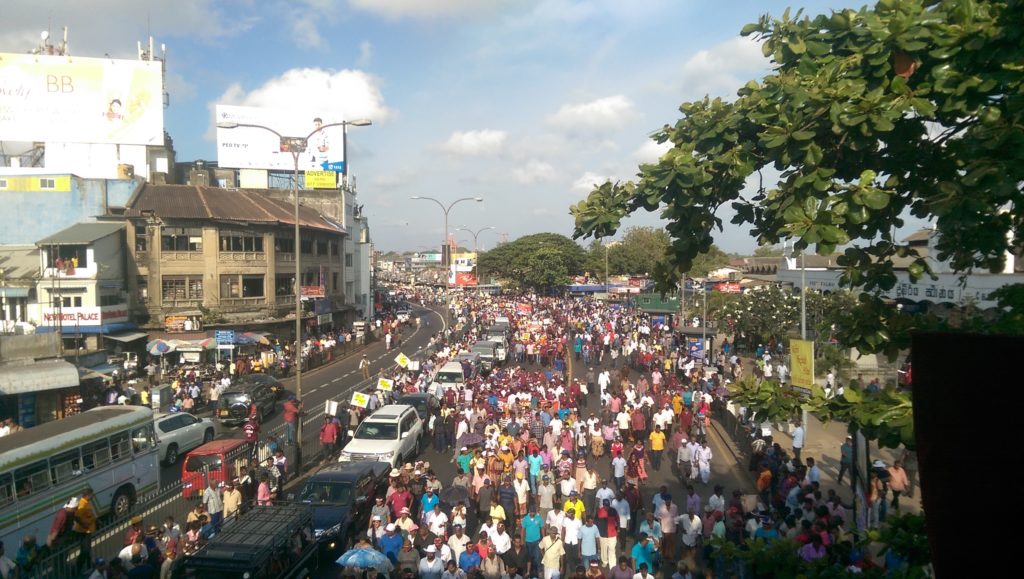

The excitement dampened fairly quickly once the participants finally arrived at Lakehouse roundabout, despite the efforts of MPs Wimal Weerawansa, Bandula Gunawardena and Vasudeva Nanayakkara. None of the Rajapaksas were anywhere to be seen. Uncertain, groups began drifting towards the back.
The atmosphere was celebratory, rather like an impromptu street party. Perhaps the reason for this was the lack of tension.
Although Namal Rajapaksa charged that there had been “rising number of attacks on people travelling for the Jana Balaya protest” and that the protesters were being obstructed, the only complaint, as police spokesman Ruwan Gunasekara later told Groundviews was from Hali-Ela, Badulla, where a bus’ windows were smashed. It was subsequently reported that the incident was not related to the rally in Colombo.
Chants about the long, fraught journey to Colombo, and the opposition of police rang false.
The crowd was galvanised again once a satyagraha was announced. Crowds began trickling in, with Namal Rajapaksa making a brief appearance to initiate proceedings.
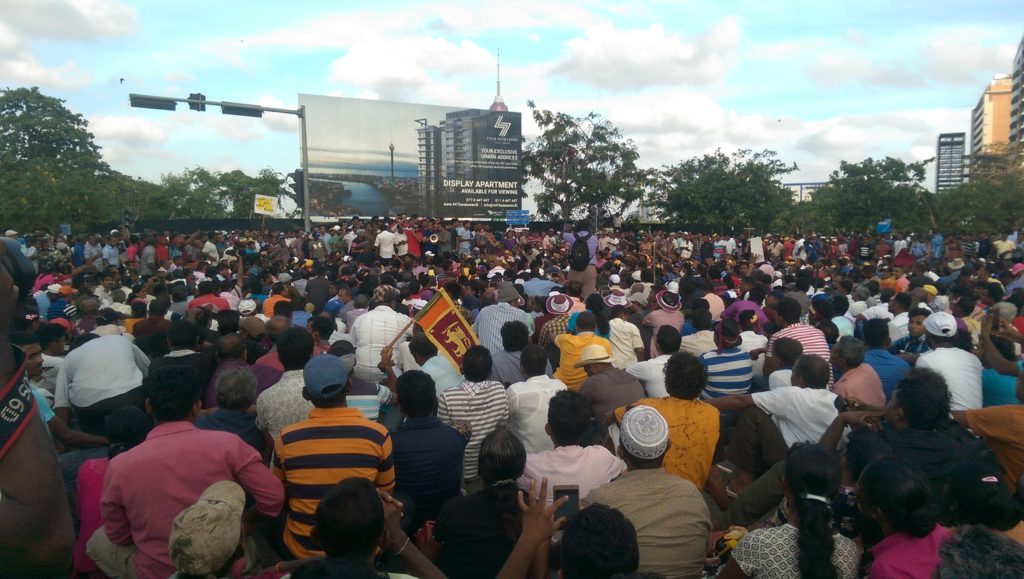
Shortly after, the former President arrived to address the rally.
Two weeks ago, reports surfaced that Mahinda Rajapaksa was considering running for a third term, igniting a debate on whether this was even possible, given the 19th amendment to the Constitution. The Elections Commission dismissed the drama as “unwarranted”. The surprise move indicated uncertainty about the Joint Opposition’s Presidential candidate for the 2020 elections, being described as a ‘litmus test’ to suss out the best candidate.
The crowd was galvanised again once a satyagraha was announced. Crowds began trickling in for an impromptu candlelight vigil, with Namal Rajapaksa making a brief appearance to initiate proceedings.
Throughout the day, it was Mahinda’s name which was heard most often, shouted in slogans and in conversation among passersby. And while each of the Rajapaksas was greeted with enthusiasm, it was the former President whose presence generated the greatest excitement – even though his microphone was malfunctioning.
On Twitter, Namal Rajapaksa said the rally was a ‘massive success’. Yet, most of the posts being shared noted that the participants seemed more interested in enjoying the music.
While JO wanted to show strength, main photos being shared highlight the carnival atmosphere, and apparent strength of what was being consumed shortly before #?????????? #lka https://t.co/ZvZOgXrXZv
— Groundviews (@groundviews) September 5, 2018
A peaceful protest rally was just what the opposition needed to steal the limelight from the government but the truth is that they could do nothing as thousands of supporters donned their Batman & Spiderman outfits poured into Colombo #?????????? pic.twitter.com/p8tSBX5UNm
— Being Yakin ® (@ItsYakin) September 8, 2018
#September5th #?????????? pic.twitter.com/BoUxLcHrbN
— Ranga Sirilal (@rangaba) September 5, 2018
The Joint Opposition themselves made several faux pas during the protest. While tweeting confidently that hundreds more continued to make their way to Colombo, Namal Rajapaksa (or his social media manager) appeared to have accidentally recorded him asking if more participants were on the way, with disembodied voices assuring him that this was the case.
#September5th #?????????? mass protest well in progress & coordinators inform that hundreds more continue to make their way to #Colombo
Today’s turnout’s a testimony of a people still hopeful for #SriLanka despite being faced with a Gov that clearly does not care about the people pic.twitter.com/CAVbsD0qWm— Namal Rajapaksa (@RajapaksaNamal) September 5, 2018
Tellingly, the former Defense Secretary Gotabaya Rajapaksa shared a drone photo of an old rally from Nugegoda, only to promptly delete it after it was flagged by MP Ranjan Ramanayake.
They know it's a big failure, that's why poor @RajapaksaNamal team sharing the old Nugegoda rally pic to show the crowd, what a decline from 2015, I don't know how Nugegoda become Fort pic.twitter.com/djxDWqsyl1
— Ranjan Ramanayake (@RamanayakeR) September 5, 2018
While the rally organisers were saying that ‘thousands of buses were pouring into Colombo’, Groundviews’ Founding Editor Sanjana Hattotuwa was able to ascertain, using mapping tools and photography shared by the organisers themselves, that the actual number of participants could have been at most around 86,557 but in reality, was much closer to just 50,000. This was much less than the May Day rally in 2017, the hordes of people who turned out for a rally featuring Mahinda Rajapaksa in January 2017, and a far cry from the over 200,000 expected, going by what the organisers themselves noted. Namal Rajapaksa called the data-driven report “false news” and “vilification” – to no avail.
At the rally, it was interesting to note that the focal point of attention for the crowd remained the former President. If Jana Balaya was a litmus test to determine the popularity of a candidate beyond Mahinda Rajapaksa, it could hardly be called a success.
But this should be no grounds for complacency on the part of the Government. Apart from the facetious attempts to portray diversity, participants also waved signs on corruption and shrinking economic growth – real concerns that the State will have to meaningfully address. This is especially true as issues like corruption are viewed as more immediate than, for example, more abstract (though no less vital) concerns around freedom of expression. In the recent past, the Government has generated its own fair share of communications debacles – from the President’s stance on the death penalty (which he recently, and risibly, added was a suitable punishment for misuse of public funds) to more recent, disturbing news of MP Ravi Karunanayake regaining a Ministerial portfolio, even though the former Finance Minister lost his seat following revelations around the Central Bank bond issue.
The Government can see the confusion around Jana Balaya as a lesson, and an opportunity. Whether they will seize it remains an open question.
Follow along with the rally here, or scroll below:
Tracking #?????????? https://t.co/8zgvpjlsJh #lka #SriLanka #September5th
— Groundviews (@groundviews) September 7, 2018
Editor’s Note: Also read “Jana Bala Sena Rally“

